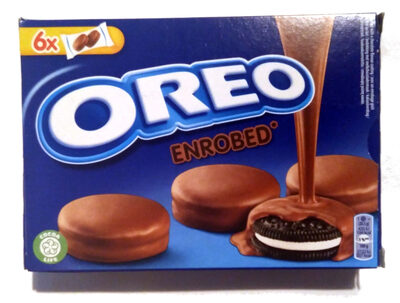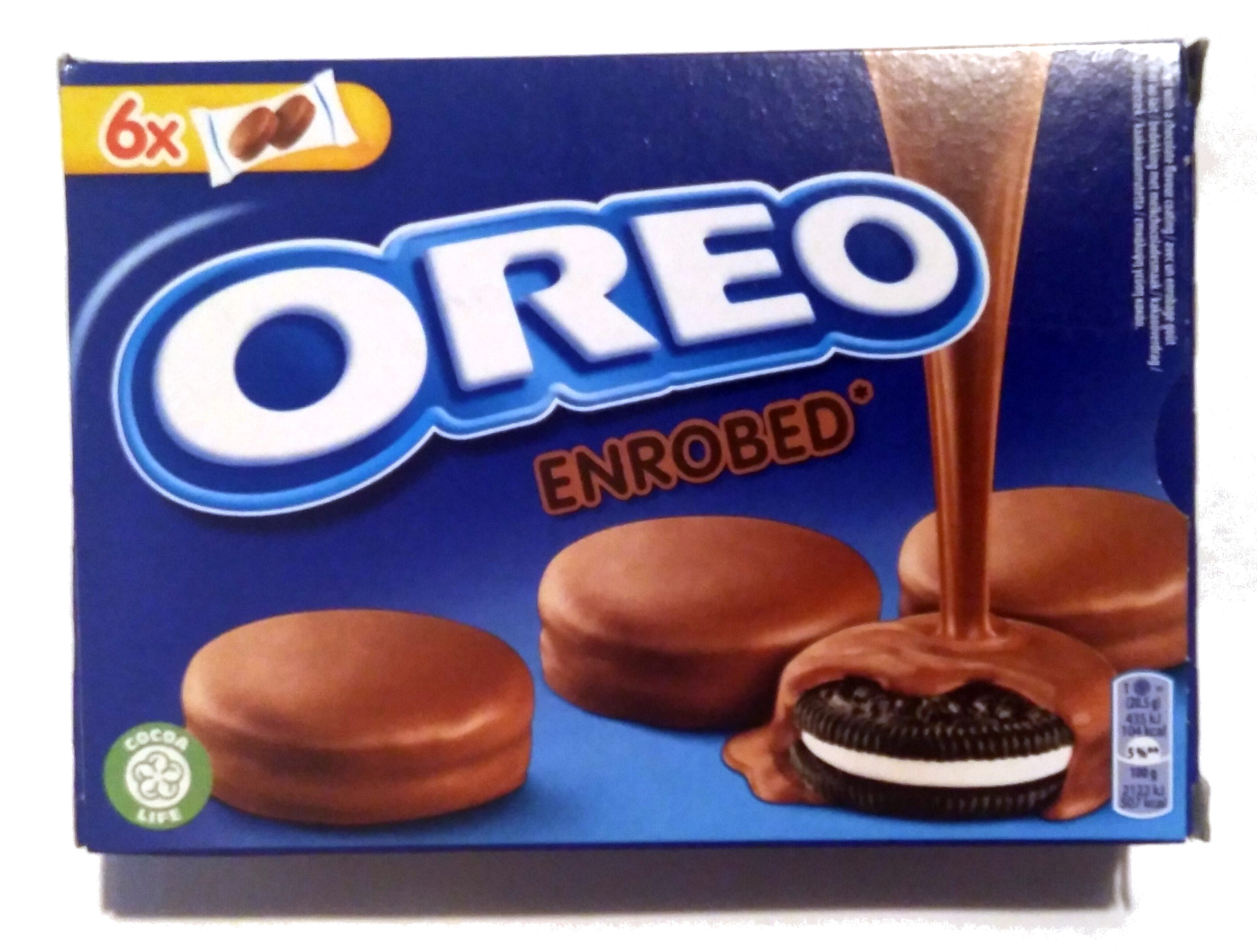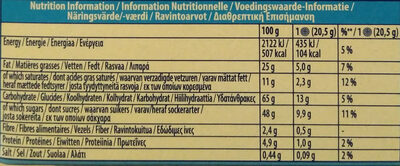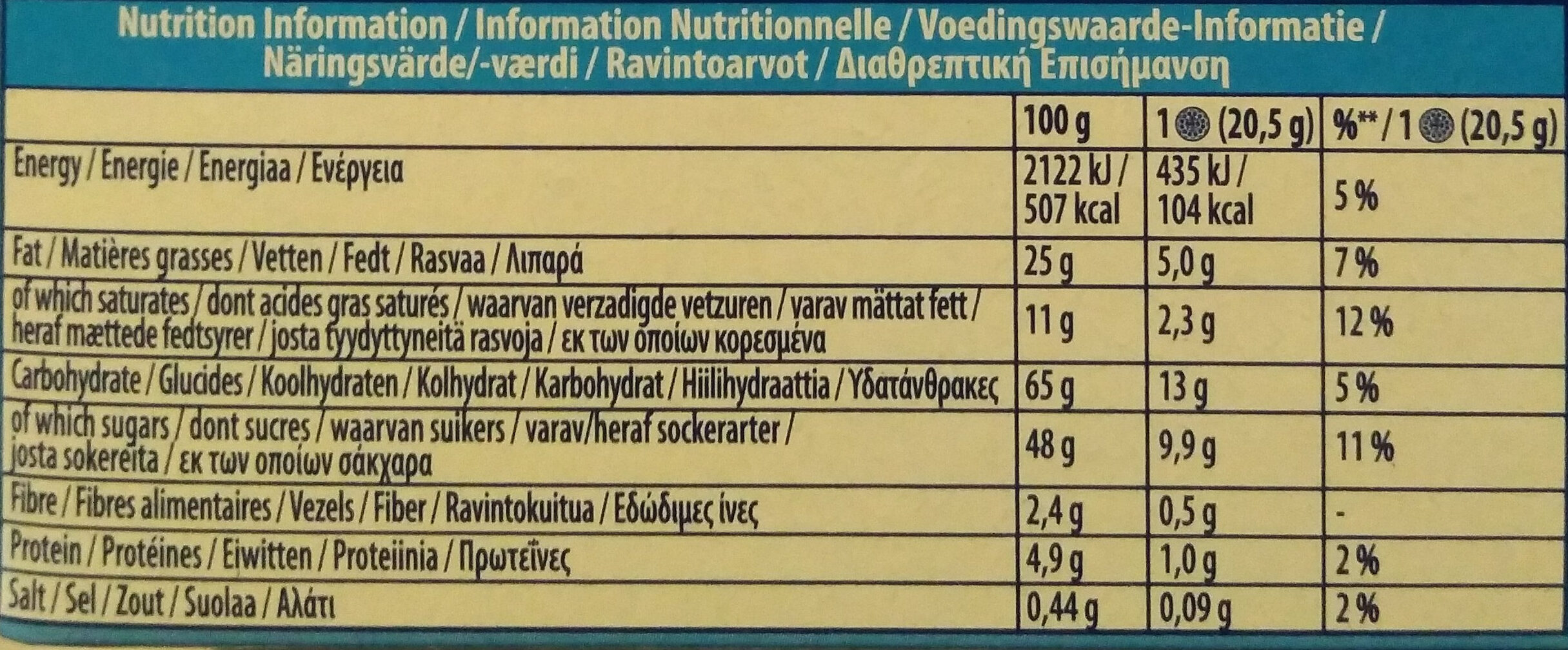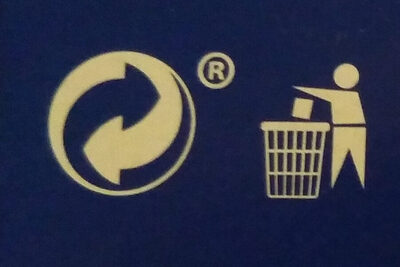Help us make food transparency the norm!
As a non-profit organization, we depend on your donations to continue informing consumers around the world about what they eat.
The food revolution starts with you!
Oreo Enrobed - ℮ 246 g
Oreo Enrobed - ℮ 246 g
This product page is not complete. You can help to complete it by editing it and adding more data from the photos we have, or by taking more photos using the app for Android or iPhone/iPad. Thank you!
×
Streckkod: 7622300489434 (EAN / EAN-13)
Vanligt namn: Kakaokex (38%) med krämfyllning (19%) och kakaoöverdrag (43%)
Kvantitet: ℮ 246 g
Förpackning:
en:Green Dot, fr:Boite en carton, fr:Sachets plastique
Kategorier: Snacks, Söta snacks, Kakor och tårtor, Kex, en:Chocolate biscuits, en:Filled biscuits, en:Milk chocolate biscuits, en:Chocolate sandwich cookies
Etiketter, certifieringar, utmärkelser:
Vegetarisk, Cocoa Life, en:Green Dot, Triman, en:Verified


Butiker: Magasins U, Delhaize, K-market, carrefour.fr
Länder där såld: Belgien, Danmark, Finland, Frankrike, Grekland, Irland, Italien, Marocko, Nederländerna, Norge, Sverige, Storbritannien
Matching with your preferences
Hälsa
Ingredienser
-
22 ingredienser
Socker, VETEMJÖL, palmolja, sheaolja, fettreducerad kakao 4,5%, rapsolja, SKUMMJÖLKSPULVER, VETESTÄRKELSE, laktos (MJÖLK), glukos-fruktossirup, emulgeringsmedel (SOJALECITIN, E492, solroslecitin, E476), bakpulver(kaliumkarbonater, ammoniumkarbonater, natriumkarbonater), salt, aromer.Allergener: Gluten, Mjölk, SojaSpår: Gluten, Mjölk, Soja
Food processing
-
Ultra processed foods
Elements that indicate the product is in the 4 - Ultra bearbetade livsmedel och drycker group:
- Tillsats: E322 - Lecitiner
- Tillsats: E476 - Polyglycerolpolyricinoleat
- Tillsats: E492 - Sorbitantristearat
- Ingrediens: Emulgeringsmedel
- Ingrediens: Arom
- Ingrediens: Glukos
- Ingrediens: Laktos
Food products are classified into 4 groups according to their degree of processing:
- Obearbetade eller minimalt bearbetade livsmedel
- Bearbetade kulinariska ingredienser
- Halvfabrikat
- Ultra processed foods
The determination of the group is based on the category of the product and on the ingredients it contains.
Tillsatser
-
E322 - Lecitiner
Lecithin: Lecithin -UK: , US: , from the Greek lekithos, "egg yolk"- is a generic term to designate any group of yellow-brownish fatty substances occurring in animal and plant tissues, which are amphiphilic – they attract both water and fatty substances -and so are both hydrophilic and lipophilic-, and are used for smoothing food textures, dissolving powders -emulsifying-, homogenizing liquid mixtures, and repelling sticking materials.Lecithins are mixtures of glycerophospholipids including phosphatidylcholine, phosphatidylethanolamine, phosphatidylinositol, phosphatidylserine, and phosphatidic acid.Lecithin was first isolated in 1845 by the French chemist and pharmacist Theodore Gobley. In 1850, he named the phosphatidylcholine lécithine. Gobley originally isolated lecithin from egg yolk—λέκιθος lekithos is "egg yolk" in Ancient Greek—and established the complete chemical formula of phosphatidylcholine in 1874; in between, he had demonstrated the presence of lecithin in a variety of biological matters, including venous blood, in human lungs, bile, human brain tissue, fish eggs, fish roe, and chicken and sheep brain. Lecithin can easily be extracted chemically using solvents such as hexane, ethanol, acetone, petroleum ether, benzene, etc., or extraction can be done mechanically. It is usually available from sources such as soybeans, eggs, milk, marine sources, rapeseed, cottonseed, and sunflower. It has low solubility in water, but is an excellent emulsifier. In aqueous solution, its phospholipids can form either liposomes, bilayer sheets, micelles, or lamellar structures, depending on hydration and temperature. This results in a type of surfactant that usually is classified as amphipathic. Lecithin is sold as a food additive and dietary supplement. In cooking, it is sometimes used as an emulsifier and to prevent sticking, for example in nonstick cooking spray.Källa: Wikipedia (Engelska)
-
E322i - Lecitin
Lecithin: Lecithin -UK: , US: , from the Greek lekithos, "egg yolk"- is a generic term to designate any group of yellow-brownish fatty substances occurring in animal and plant tissues, which are amphiphilic – they attract both water and fatty substances -and so are both hydrophilic and lipophilic-, and are used for smoothing food textures, dissolving powders -emulsifying-, homogenizing liquid mixtures, and repelling sticking materials.Lecithins are mixtures of glycerophospholipids including phosphatidylcholine, phosphatidylethanolamine, phosphatidylinositol, phosphatidylserine, and phosphatidic acid.Lecithin was first isolated in 1845 by the French chemist and pharmacist Theodore Gobley. In 1850, he named the phosphatidylcholine lécithine. Gobley originally isolated lecithin from egg yolk—λέκιθος lekithos is "egg yolk" in Ancient Greek—and established the complete chemical formula of phosphatidylcholine in 1874; in between, he had demonstrated the presence of lecithin in a variety of biological matters, including venous blood, in human lungs, bile, human brain tissue, fish eggs, fish roe, and chicken and sheep brain. Lecithin can easily be extracted chemically using solvents such as hexane, ethanol, acetone, petroleum ether, benzene, etc., or extraction can be done mechanically. It is usually available from sources such as soybeans, eggs, milk, marine sources, rapeseed, cottonseed, and sunflower. It has low solubility in water, but is an excellent emulsifier. In aqueous solution, its phospholipids can form either liposomes, bilayer sheets, micelles, or lamellar structures, depending on hydration and temperature. This results in a type of surfactant that usually is classified as amphipathic. Lecithin is sold as a food additive and dietary supplement. In cooking, it is sometimes used as an emulsifier and to prevent sticking, for example in nonstick cooking spray.Källa: Wikipedia (Engelska)
-
E476 - Polyglycerolpolyricinoleat
Polyglycerol polyricinoleate: Polyglycerol polyricinoleate -PGPR-, E476, is an emulsifier made from glycerol and fatty acids -usually from castor bean, but also from soybean oil-. In chocolate, compound chocolate and similar coatings, PGPR is mainly used with another substance like lecithin to reduce viscosity. It is used at low levels -below 0.5%-, and works by decreasing the friction between the solid particles -e.g. cacao, sugar, milk- in molten chocolate, reducing the yield stress so that it flows more easily, approaching the behaviour of a Newtonian fluid. It can also be used as an emulsifier in spreads and in salad dressings, or to improve the texture of baked goods. It is made up of a short chain of glycerol molecules connected by ether bonds, with ricinoleic acid side chains connected by ester bonds. PGPR is a yellowish, viscous liquid, and is strongly lipophilic: it is soluble in fats and oils and insoluble in water and ethanol.Källa: Wikipedia (Engelska)
-
E492 - Sorbitantristearat
Sorbitan tristearate: Sorbitan tristearate is a nonionic surfactant. It is variously used as a dispersing agent, emulsifier, and stabilizer, in food and in aerosol sprays. As a food additive, it has the E number E492. Brand names for polysorbates include Alkest, Canarcel, and Span. The consistency of sorbitan tristearate is waxy; its color is light cream to tan.Källa: Wikipedia (Engelska)
Ingrediensanalys
-
Palmolja
Ingredienser som innehåller palmolja: Palmolja
-
Icke-vegan
Non-vegan ingredients: Skummjölkspulver, Laktos, Mjölk
-
Vegetariskt
No non-vegetarian ingredients detected
-
Details of the analysis of the ingredients
en: sugar, wheat flour, palm oil, shea oil, fat-reduced cocoa powder 4.5%, rapeseed oil, skimmed milk powder, wheat starch, lactose (from milk), glucose-fructose syrup, emulsifiers (soya lecithin, e492, sunflower lecithin, e476), raising agents (potassium carbonates, ammonium carbonates, sodium carbonates), salt, flavourings- sugar -> en:sugar - vegan: yes - vegetarian: yes - ciqual_proxy_food_code: 31016 - percent_min: 7.14285714285714 - percent_max: 82
- wheat flour -> en:wheat-flour - vegan: yes - vegetarian: yes - ciqual_proxy_food_code: 9410 - percent_min: 4.5 - percent_max: 43.25
- palm oil -> en:palm-oil - vegan: yes - vegetarian: yes - from_palm_oil: yes - ciqual_food_code: 16129 - percent_min: 4.5 - percent_max: 30.3333333333333
- shea oil -> en:shea-oil - vegan: yes - vegetarian: yes - from_palm_oil: no - percent_min: 4.5 - percent_max: 23.875
- fat-reduced cocoa powder -> en:fat-reduced-cocoa-powder - vegan: yes - vegetarian: yes - ciqual_food_code: 18100 - percent_min: 4.5 - percent: 4.5 - percent_max: 4.5
- rapeseed oil -> en:rapeseed-oil - vegan: yes - vegetarian: yes - from_palm_oil: no - percent_min: 0 - percent_max: 4.5
- skimmed milk powder -> en:skimmed-milk-powder - vegan: no - vegetarian: yes - ciqual_food_code: 19054 - percent_min: 0 - percent_max: 4.5
- wheat starch -> en:wheat-starch - vegan: yes - vegetarian: yes - ciqual_proxy_food_code: 9510 - percent_min: 0 - percent_max: 4.5
- lactose -> en:lactose - vegan: no - vegetarian: yes - percent_min: 0 - percent_max: 4.5
- from milk -> en:milk - vegan: no - vegetarian: yes - ciqual_proxy_food_code: 19051 - percent_min: 0 - percent_max: 4.5
- glucose-fructose syrup -> en:glucose-fructose-syrup - vegan: yes - vegetarian: yes - ciqual_food_code: 31077 - percent_min: 0 - percent_max: 4.5
- emulsifiers -> en:emulsifier - percent_min: 0 - percent_max: 4.5
- soya lecithin -> en:soya-lecithin - vegan: yes - vegetarian: yes - ciqual_food_code: 42200 - percent_min: 0 - percent_max: 4.5
- e492 -> en:e492 - vegan: maybe - vegetarian: maybe - percent_min: 0 - percent_max: 2.25
- sunflower lecithin -> en:sunflower-lecithin - vegan: yes - vegetarian: yes - percent_min: 0 - percent_max: 1.5
- e476 -> en:e476 - vegan: yes - vegetarian: yes - percent_min: 0 - percent_max: 1.125
- raising agents -> en:raising-agent - percent_min: 0 - percent_max: 4.5
- potassium carbonates -> en:e501 - vegan: yes - vegetarian: yes - percent_min: 0 - percent_max: 4.5
- ammonium carbonates -> en:e503 - vegan: yes - vegetarian: yes - percent_min: 0 - percent_max: 2.25
- sodium carbonates -> en:e500 - vegan: yes - vegetarian: yes - percent_min: 0 - percent_max: 1.5
- salt -> en:salt - vegan: yes - vegetarian: yes - ciqual_food_code: 11058 - percent_min: 0 - percent_max: 0.44
- flavourings -> en:flavouring - vegan: maybe - vegetarian: maybe - percent_min: 0 - percent_max: 0.44
Näring
-
Bad nutritional quality
⚠ ️Warning: the amount of fruits, vegetables and nuts is not specified on the label, it was estimated from the list of ingredients: 0This product is not considered a beverage for the calculation of the Nutri-Score.
Positiva poäng: 2
- Proteiner: 2 / 5 (värde: 4.8, avrundat värde: 4.8)
- Fiber: 2 / 5 (värde: 2, avrundat värde: 2)
- Frukt, grönsaker, nötter och raps- / valnöt- / olivoljor: 0 / 5 (värde: 0.15922619047619, avrundat värde: 0.2)
Negativa poäng: 27
- Energi: 6 / 10 (värde: 2122, avrundat värde: 2122)
- Socker: 10 / 10 (värde: 47.5, avrundat värde: 47.5)
- Mättat fett: 10 / 10 (värde: 13.5, avrundat värde: 13.5)
- Natrium: 1 / 10 (värde: 176, avrundat värde: 176)
The points for proteins are not counted because the negative points are greater or equal to 11.
Näringsvärde: (27 - 2)
Nutri-Score:
-
Näringsvärden
-
Fett i hög kvantitet (25%)
What you need to know- A high consumption of fat, especially saturated fats, can raise cholesterol, which increases the risk of heart diseases.
Recommendation: Limit the consumption of fat and saturated fat- Choose products with lower fat and saturated fat content.
-
Mättat fett i hög kvantitet (13.5%)
What you need to know- A high consumption of fat, especially saturated fats, can raise cholesterol, which increases the risk of heart diseases.
Recommendation: Limit the consumption of fat and saturated fat- Choose products with lower fat and saturated fat content.
-
Sockerarter i hög kvantitet (47.5%)
What you need to know- A high consumption of sugar can cause weight gain and tooth decay. It also augments the risk of type 2 diabetes and cardio-vascular diseases.
Recommendation: Limit the consumption of sugar and sugary drinks- Sugary drinks (such as sodas, fruit beverages, and fruit juices and nectars) should be limited as much as possible (no more than 1 glass a day).
- Choose products with lower sugar content and reduce the consumption of products with added sugars.
-
Salt i måttlig kvantitet (0.44%)
What you need to know- A high consumption of salt (or sodium) can cause raised blood pressure, which can increase the risk of heart disease and stroke.
- Many people who have high blood pressure do not know it, as there are often no symptoms.
- Most people consume too much salt (on average 9 to 12 grams per day), around twice the recommended maximum level of intake.
Recommendation: Limit the consumption of salt and salted food- Reduce the quantity of salt used when cooking, and don't salt again at the table.
- Limit the consumption of salty snacks and choose products with lower salt content.
-
-
Näringsfakta
Näringsfakta Som såld
för 100 g / 100 mlSom såld
per portion (20,5g)Compared to: en:Filled biscuits Energi 2 122 kj
(505 kcal)435 kj
(104 kcal)+7 % Fett 25 g 5,12 g +26 % Mättat fett 13,5 g 2,77 g +34 % Kolhydrat 65 g 13,3 g −2 % Sockerarter 47,5 g 9,74 g +24 % Fiber 2 g 0,41 g Protein 4,8 g 0,984 g +3 % Salt 0,44 g 0,09 g −20 % Fruits‚ vegetables‚ nuts and rapeseed‚ walnut and olive oils (estimate from ingredients list analysis) 0,159 % 0,159 %
Miljö
-
Eco-Score D - Hög miljöpåverkan
The Eco-Score is an experimental score that summarizes the environmental impacts of food products.→ The Eco-Score was initially developped for France and it is being extended to other European countries. The Eco-Score formula is subject to change as it is regularly improved to make it more precise and better suited to each country.Life cycle analysis
-
Average impact of products of the same category: C (Score: 56/100)
Kategori: Biscuit (cookie), snack with dairy or vanilla filling
Kategori: Biscuit (cookie), snack with dairy or vanilla filling
- PEF environmental score: 0.47 (the lower the score, the lower the impact)
- including impact on climate change: 5.92 kg CO2 eq/kg of product
Stage Impact Jordbruk
63.6 %Bearbetar
29.8 %Förpackning
2.3 %Transportation
3.2 %Distribution
1.0 %Consumption
0.0 %
Bonuses and maluses
-
Missing origins of ingredients information
Malus: -5
⚠ ️ The origins of the ingredients of this product are not indicated.
If they are indicated on the packaging, you can modify the product sheet and add them.
If you are the manufacturer of this product, you can send us the information with our free platform for producers.
-
Ingredients that threatens species
Malus: -10
Contains palm oil
Tropical forests in Asia, Africa and Latin America are destroyed to create and expand oil palm tree plantations. The deforestation contributes to climate change, and it endangers species such as the orangutan, the pigmy elephant and the Sumatran rhino.
-
Packaging with a medium impact
Malus: -11
Form Material Återvinning Impact Bag Plast Hög Box Kartong Låg
Eco-Score for this product
-
Impact for this product: D (Score: 30/100)
Produkt: Oreo Enrobed - ℮ 246 g
Life cycle analysis score: 56
Sum of bonuses and maluses: -26
Final score: 30/100
-
Carbon footprint
-
Equal to driving 3.1 km in a petrol car
592 g CO² per 100g of product
The carbon emission figure comes from ADEME's Agribalyse database, for the category: Biscuit (cookie), snack with dairy or vanilla filling (Source: ADEME Agribalyse Database)
Stage Impact Jordbruk
52.9 %Bearbetar
42.0 %Förpackning
1.9 %Transportation
2.9 %Distribution
0.3 %Consumption
0.0 %
Förpackning
-
Packaging with a medium impact
-
Packaging parts
Bag (Plast)
Box (Kartong)
-
Packaging materials
Material % Packaging weight Packaging weight per 100 g of product Paper or cardboard Plast Total
-
Transportation
-
Origins of ingredients
Missing origins of ingredients information
⚠ ️ The origins of the ingredients of this product are not indicated.
If they are indicated on the packaging, you can modify the product sheet and add them.
If you are the manufacturer of this product, you can send us the information with our free platform for producers.Add the origins of ingredients for this product Add the origins of ingredients for this product
Hotade arter
-
Contains palm oil
Drives deforestation and threatens species such as the orangutan
Tropical forests in Asia, Africa and Latin America are destroyed to create and expand oil palm tree plantations. The deforestation contributes to climate change, and it endangers species such as the orangutan, the pigmy elephant and the Sumatran rhino.
Report a problem
-
Incomplete or incorrect information?
Category, labels, ingredients, allergens, nutritional information, photos etc.
If the information does not match the information on the packaging, please complete or correct it. Open Food Facts is a collaborative database, and every contribution is useful for all.
Datakällor
Produkt tillagd den av nash
Senast ändrad produktsida på av inf.
Produktsida också redigerad av asmoth, charlesnepote, countrybot, date-limite-app, desan, driveoff, isabel626, jeanbono, jumati, kiliweb, magasins-u, manu1400, mooniie, openfoodfacts-contributors, packbot, quechoisir, scanbot, tacite, yuka.UXE0bU5iOWJxUGdZb2N3UjhqelIzUHNseTRHTWNEK3hCcklXSVE9PQ, yuka.VEs0eENhTlpnTUlvbWZCdnBVenozb3ROMVpUeGNWaVpMZThSSVE9PQ, yuka.WWFrcUgvb2Rvdk1hd013TytpcUlvYzVmMjVud1EyS1dDOFFRSWc9PQ, yuka.sY2b0xO6T85zoF3NwEKvlncdTvCC-m7GMQzWv3O0-vO1EazCOOks-YrjMqs, zoneblockscommunity.
